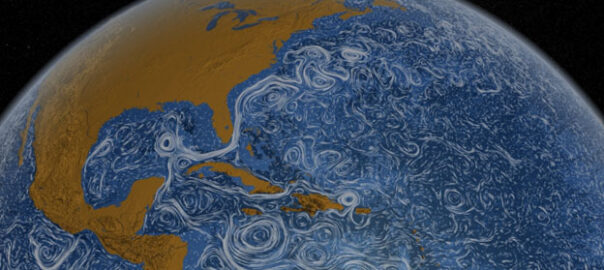
The Climate on the Eve of Civilization
The changing of the Earth’s orbit ten to twenty thousand years ago increased the amount of solar energy reaching the planet by more than 10%, resulting in the warming of the Earth, which in turn enabled the birth of agriculture—and civilization.
When the climate first emerges from a glacial period, it can be very unstable, flipping rapidly between thaw and freeze. One dramatic episode may be particularly relevant to our current situation. About 13,000 years ago, in just a few years, perhaps even a few months, average temperatures in the northern latitudes dropped as much as 15°C and remained down at that level for more than 1,000 years.
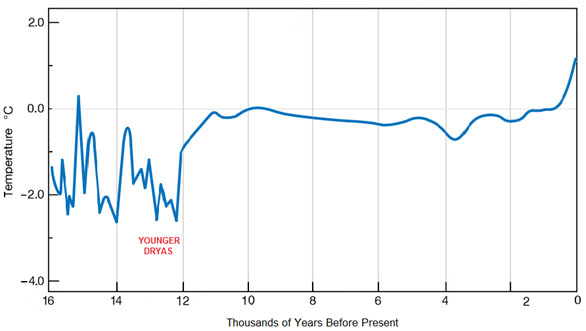
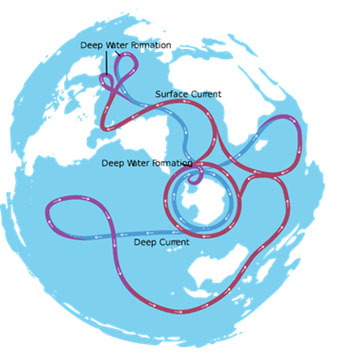
Climatologists call this period the “Younger Dryas,” named after an alpine flower that left a fossil record of the event. Melting glaciers grew back over the northern hemisphere. Nothing like this has happened since. What could have caused the sudden reversal? The answer is found in the behavior of the Gulf Stream, a crucial leg in a world-circling current that brings warm, salty water from the tropics to the poles. This is thermohaline circulation, “the ocean conveyer belt” that snakes through all of the world’s oceans, taking hundreds of years or more to complete its twisting loop.
The Collapse of the Gulf Stream
[The] Gulf Stream [is] a crucial leg in a world-circling current that brings warm salty water from the tropics to the poles.
As we’ve seen, the rise of the Isthmus of Panama blocked the flow between the Atlantic and Pacific and created the Gulf Stream. Part of it flows from the Caribbean up past Greenland and warms Northern Europe. The Gulf Stream also drags along air heavy with tropical moisture that becomes snowfall when it cools over the Arctic. Traveling north, the Gulf Stream cools and becomes saltier as its warm surface water evaporates, making the water denser. The colder, saltier water sinks into the deep ocean and flows back to the tropics.
The freeze of the Younger Dryas, surprisingly, was caused by rapid warming. The melting glaciers had created Lake Agassiz, an enormous body of fresh water that covered much of North America. Lake Agassiz was held in place by giant ice dams left behind by the melting glaciers. When these ice dams collapsed, a fresh-water flood of biblical proportions spilled into the North Atlantic off the southern coast of Greenland, diluting the salt water and stopping it from sinking and turning south; the Gulf Stream circulation stopped.
Sea levels around the entire world may have risen suddenly as much as 3m (about 10 feet). Northern Europe froze again. The Younger Dryas was the most recent such event—it also happened in previous interglacial periods. This scenario was dramatized (and greatly exaggerated) in the film The Day After Tomorrow (20th Century Studios, 2004), based on a study commissioned by the US military about the future collapse of the Greenland Ice Sheet. Eventually the increase in solar energy from the change in Earth’s orbit caused temperatures to resume the warming trend.
Climate in Recorded History
Bad weather has played a dramatic role in human history, sometimes destroying military ambitions—the defeat of the Spanish Armada, Napoleon’s retreat from Russia, and so on. It is striking then to realize that even these famous events were minor in comparison to weather extremes in the past. Unlike our robust hunter-gatherer ancestors, we are at risk from even small changes in climate. An episode that began about 1,000 years ago illustrates this sensitivity. It is studied not only from ice cores and tree rings but also from the writings of the Europeans alive at the time.

Europe was just at the end of the Medieval Warm Period around 1300 CE. This was a time of unprecedented progress in Europe (the climate record outside of Europe is less well known). Populations flourished, modern nation states began, cathedrals were built, the first universities were founded, farms were established in Greenland. But compared to some conditions of pre-history, the temperature change was almost trivial. The Northern Hemisphere overall experienced an average increase of 1°C or less, with some greater local variations.
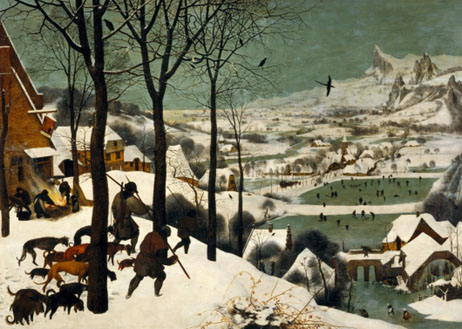
The Medieval Warm Period gave way to the Little Ice Age. This lasted all the way until the 1850s but was especially harsh in the 1500s and 1600s. It was by no means a true ice age—temperatures were an average of 1°C or less below 20th century norms (again there were greater local variations). Farming was difficult, and famine was commonplace. There are rural areas in Europe that even today have not recovered their populations. One can almost feel the chill of the harsh winters depicted in the paintings of the Breugels, father and son.
In the case of the Little Ice Age, greater volcanic activity may have cooled the Arctic for a long enough time for an increase in ice formation to slow the circulation.
Finding the causes of such small climate changes is difficult but important because of their critical effects. It appears that both the Medieval Warm Period and the Little Ice Age resulted from changes in the thermohaline circulation. In the Medieval Warm Period, a temporary increase in the sun’s output and lower than average volcanic activity caused a small increase in warmth that led to an increase the Gulf Stream. In the case of the Little Ice Age, greater volcanic activity may have cooled the Arctic for a long enough time for an increase in ice formation to slow the circulation.
The Chance of a Lifetime
The world relies on the agricultural exports of three critical regions: the Midwest of the United States, the Indo-Ganges plain, and the Pampas of South America.
Ten thousand years ago our ancestors launched us on this journey based on six good inches of soil and temperate weather suitable for its cultivation. This hasn’t changed. Regardless of the advanced state of our science, all civilization is founded on the ability of a few individuals to grow food for a great many people who no longer do this for themselves. The world relies on the agricultural exports of three critical regions: the Midwest of the United States, the Indo-Ganges plain, and the Pampas of South America. Each of these regions has experienced extreme weather in recent years—drought, heat waves, damaging floods, sometimes following one after the other.
The loss of these agricultural resources would cause not only hunger but political instability. With “old-mind” thinking, populist leaders of discontents typically stand for policies that would make our future environment a disaster. A “new-mind” approach might permit people in industrialized countries to understand the level of comfort and security they enjoy, and the power that gives us. To quote Al Gore from Our Choice: A Plan to Solve the Climate Crisis, “We should feel a sense of joy that those of us alive today have … the chance to undertake an historic mission worthy of our best efforts.“
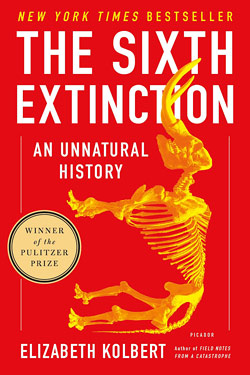
The Sixth Extinction
An Unnatural History
Elizabeth Kolbert
With all of Earth’s five mass extinctions, the climate changed faster than any species could adapt. The current extinction has the same random and rapid properties, but it’s unique in that it’s caused entirely by the actions of a single species—humans.

Foragers, Farmers, and Fossil Fuels
Ian Morris
Human social development, says Morris, is constantly generated by environmental and social factors. The amount of energy that can be extracted from the environment through technology defines the social possibilities, and thus influences the attitudes and world view of each epoch.
In the series: Our Finite Planet
Related articles:
Further Reading »
External Stories and Videos
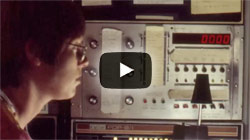
Watch: Cosmic Knowledge and the Future of the Human Race
Sandra Faber, Kraw Lecture Series, UC Santa Cruz
National Medal of Science winner Sandra Faber describes how the profound insights of cosmology take the issue of sustainability out of the personal and into a more objective consideration of where – and if – we are going.
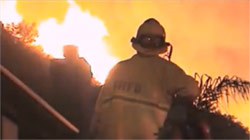
Watch: David Wallace-Wells | The Uninhabitable Earth
Extinction Radio
Famine, economic collapse, a sun that cooks us: What climate change could wreak — sooner than you think.
